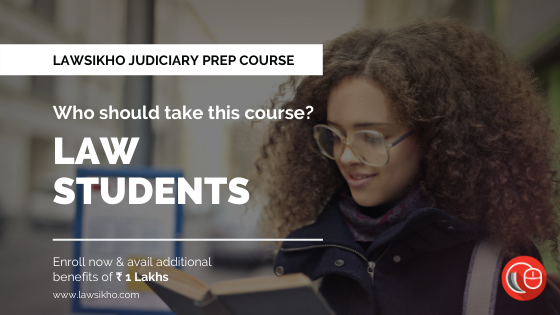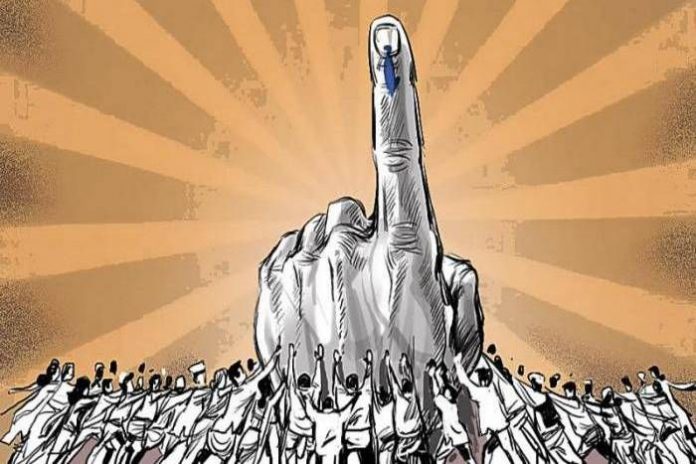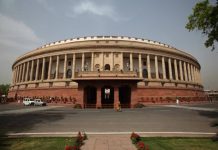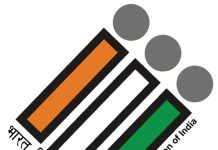This article is written by Kartikey Mishra, a student of Llyod Law College. In this article, he explains the concept of Simultaneous Elections with respect to India, its background and what are the international perspectives relating to it.
Table of Contents
Introduction
India is a democratic country according to the preamble of the constitution, but due to frequent elections in India, those days are not far when people will call India as Election Country because of every year there are two or more than two elections are held in one or the other states.
Taking the current example of Lok Sabha (Lower House) election 2019 which ended on 22 May and now Haryana representative started working for the elections of Vidhan Sabha elections which in the month of November. This example is enough to understand the status of the representative and how much they get time to work for the people.
The term Election is derived from the Latin term “eligere” means “choose”. According to Oxford dictionary define it as “A formal and organized choice by a vote of a person for a political office or other position.” This was just the definition of term election, now the term general election, according to Merriam Webster it means “an election usually held at regular intervals in which candidates are elected in all or most constituencies of a nation or state”.
What is the Purpose of Elections?
We all have elections in our country every year, but many of us don’t know the purpose of it, different people have a different meaning, it’s a paradox understanding between representative and voters. For representative election give seats, power but for voters, it gives them a chance to them for showing their power. The above two objects can be said as a purpose but its ambit is broader.
- Elections make a fundamental contribution to democratic governance.
- Elections enable voters to select leaders and to hold them accountable for their performance in office.
- Elections help them in building the public opinions of the citizens.
- Voting gives people an opportunity to have their say and, through expressing partisanship, to satisfy their need to feel a sense of belonging.
- Even nonvoting in elections satisfies the need of some people to express their alienation from the political community.
As we have gone through the purpose of having election, now whether we able to cope up with the definition and the purposes of an election, in virtually, Yes but feasibly No, because in definition the term “regular interval” is used now we have the election in regular intervals but that intervals are coming every year, India is having elections every year in some or the other state now to which our administration is not able to work properly, it is not creating accountability of the elected member, because of regular elections and etc. issues. So, after having these kinds of issues an idea emerged in the mind of officials “Simultaneous Elections”.
Now, before we go in deep of this lets first get the definition, history and basic idea of this “In popular sense of the term, “simultaneous elections” refers to elections to all the three tiers of the government or Constitutional institutions set up in that country i.e. House of the People (Lok Sabha), State Assemblies (Vidhan Sabha) and Local bodies taking place in a synchronized manner.” But in the case of India, ‘the third tire’ institutions, they are number is too much in number also conduct of the election of the same is primarily a State subject. As per the Constitution, the elections to the third tier institutions are directed and controlled by their respective State Election Commissions. Therefore, it would be extremely challenging, if not impossible, to synchronized and align election schedules of third-tier with that of the House of the People and State Legislative Assemblies. So the definition of Simultaneous Election is restricted till two tiers only.

Background
We all will surprise to know, the history of elections in India is itself a shred of evidence that we had conducted the elections simultaneously in the past, one finds that during the first two decades after independence, general elections for the House of the People and the State Legislative Assemblies were held simultaneously, i.e., during the years 1951-52, 1957, 1962 and 1967.
Also, we need to keep in mind that, Simultaneous elections would not mean that voting across the country for the House of the People and all the State Assemblies take place on a single day.
The main reasons behind the breaking of the cycle of synchronized elections were the dominance and rule by one National political party and the regional parties were not powerful and influential. The indiscriminate use of Article 356 of the Constitution also contributed to disruptions of simultaneous elections. However, with the change in Indian polity, the regional political parties not only have increased in number but have also marked their presence in the elections to the concerned State Assemblies. For Example, between 2014-2016, the country witnessed, one general and 15 state elections.
Why India should go for Simultaneous Elections?
Financial Benefits
India is still a developing country, so its responsibility of the government of India that it should try to save money of taxpayer and invest it in sectors where the public will get output. Like Health, Education, Infrastructure, etc.
There are many arrangements which are done by the government during the election. As per the data provided to the Commission by ECI, expenditure incurred on account of elections relate to:
- Setting up of the polling stations and making necessary arrangements at polling booths/counting centers;
- Payment of TA/DA etc., to polling personnel/counting staff;
- Making transport arrangements for carrying polling and counting staff to the polling and counting centers and for the movement of election material and ballot boxes;
- Making temporary telephone facilities and electrical fittings, etc., to the polling booths/counting centers;
- Purchase of election material like indelible ink, ammonia paper, etc., which are exclusively utilized for that particular election; and
- Miscellaneous expenditure for the purpose of smooth conduct of polling and counting.
The ECI estimates that there will be about 10, 60,000 polling stations for the elections to the House of the People in 2019. It further informed that as of now there is a shortfall of about 12.9 lakh Ballot Units, 9.4 lakh Control Units and about 12.3 lakh VVPATs, if simultaneous elections are to be held.
Education’s Perspective
The polling booths are most often located in schools, whether Government or private. The school staff and teaching personnel are directed to proceed for election duties, compromising their primary duty of imparting education. Apart from the day of poll, the schools remain closed even prior to the day of elections, for preparatory measures.
Hindrance in work
If we see the case with employees of Central and State Governments and the PSUs who are assigned election duty, the officials on such duty are required to abstain themselves from their normal duties to attend training relating to the conduct of the election, counting, etc. The Holding staggered elections leads to such disruptions time and again. This makes holding of simultaneous elections more desirable.
Implementation of Model Code of Conduct
The Model Code of Conduct (MCC) is a set of guidelines applicable to political parties, candidates, the election machinery, and the Government agencies, to have free and fair elections in the country/state. But it also restrains the government from doing their works like (i) announcing any financial grants in any form or promises thereof; (ii) laying foundation stones etc., of projects or schemes of any kind except by civil servants; (iii) or make any promise of construction of roads, provision of drinking water facilities, etc.; or (iv) make any ad hoc appointments in Government, Public Undertakings, etc.
Voters will be more conscious
In India, it’s very general that when we have more chance, we waste our chances this is a common psychology of a human being, and in elections, same things happen, the public has more than one opportunity to vote so they generally instead of using their vote consciously they use it “for granted”, or a there is another angle of the same can be seen in elections. For weaker section of society, elections are like festivals so they vote in thinking about “their power of vote” and “their days” and in that situation they sometimes choose the wrong representative.
Not Affects the Regional Parties and their issues
Some also may have a fear that, during the consultation with political parties, one of the State level political parties countered the argument that the State/ regional parties get marginalized, contending that the regional parties need to concentrate on the State Assembly seats and seats of the House of the People of their own State only.
For Example:
It is a known fact that in the 2014 general elections, the mood of the electorate was heavily in favour of Bhartiya Janata Party. But at the same time, the data of ECI shows that, in the case of Odisha, the Biju Janta Dal (BJD) (a regional party) increased its vote share from 37.23% in 2009 to 44.77 % in Lok Sabha Elections in 2014, contrary to the national trend.
In 2014, for example, in Delhi, during the General Elections to the House of the People, there was a wave in favour of a particular party and all the seven seats to the House of the People were won by that one party. However, just after that, when the election to Delhi Legislature was held just after few months in 2015, there was a complete back-swing and Delhi witnessed a sweep by the State Party, clearly indicating that the electorate had no confusion about whom they wanted at the Centre and who can address their local issues.
More Work for Country instead of Elections
The continuing cycle of elections in one or the other part of the country deviates the mind of a lawmaker from work to elections due to which they may be elected for 5 years by the people but work only for 3-4 years because they keep on busy in representing their party in the hope of victory in the election. Simultaneous Elections will help these lawmakers to focus more on work than on elections, it will reduce rally, Speech, road blocks, etc.
Reduce hindrance of Public
As we all know whenever there are elections, many rallies and speeches, etc. goes on, due to which blocking of roads, traffics, accidents etc. increase in numbers.
More Individualist Approach
Frequent elections lead the political parties in power to take up populist measures instead of nationalist ones. It is widely perceived by political parties that providing individual benefits is the surest way to win over voters, especially the poor. So, they play with the emotions of ordinary people by offering them perks. This perception is in accordance with our political tradition that is directed more at the individual voter than interest groups.
The Supreme Court, in S. Subramaniam Balaji v. Government of Tamil Nadu & Ors., observed that such practices shake the root of free and fair elections. Therefore, reduction in the frequency of elections, such practices are bound to reduce substantially and there will be a better focus on taking up measures which are beneficial to the public at large.
More Participation of People
According to a study undertaken by Mr. CsabaNikolenyi, a Montreal-based professor at Concordia University while studying Indian elections, used basic formulae to calculate voter motivation among others, and drew the conclusion that separate elections in India were preventing more people from participating in the democratic process.
For Example:
In Indian context, if we reflect back on the elections held in the past in various States, simultaneous elections have led to increased voter turnout in 1999, for Karnataka, Maharashtra and Andhra Pradesh, by nearly 11.5%. In 1977, simultaneous elections in Kerala with national elections augmented voter turnout by nearly 20%. Similarly, simultaneous elections in north-eastern states with national elections have been empirically shown to boost voter turnout by 21% in Arunachal Pradesh and 17% in Assam. Thus it can be concluded that simultaneous elections will indeed have a positive impact on the voter-turnout even in the geographically remote states, another very important argument stressing on the need to have simultaneous elections.
Environmental Issues
As we all know that during election time, for rally and promoting political parties, millions rupees of flues are used which as we know it is non-renewable resource millions of pamphlets are printed for the purpose of promotion due to which we cut more and more trees, also throwing pamphlets here and there on roads make our surroundings dirty. So, if we have an election once in five years then the above consumption will be reduced which will help in taking India to Sustainable India development.
Not a colourable legislature
It has been contended by a large number of persons/associations that the whole exercise of changing the law for holding the simultaneous elections is a colourable exercise of power as it is with the mala fide object to change the form of Government.
The Supreme Court, in State of Punjab v. Gurdial Singh, explained as to what amounts to colourable exercise of power, observing that when power is exercised in bad faith to attain ends beyond the sanctioned purposes of power by simulation or pretension of gaining a legitimate goal, it is called colourable exercise of power.
In R.S. Joshi v. Ajit Mills Ltd., the Court held that “malice or motive is beside the point and it is not permissible to suggest parliamentary incompetence on the score of mala fides”.
So, there is no use of ultra vires whatever steps are taken by the government are coming under the ambit of power given to the government.

Views of Reports in favour of Simultaneous Elections
In 2015, the Parliamentary Standing Committee on Personnel, Public Grievances, Law and Justice in its 79th Report suggested holding simultaneous elections for the long term good governance.
First Annual Report of the Election Commission of India, 1983
In 1983, the Election Commission of India in its First Annual Report recommended holding simultaneous elections for the House of the People and the Legislative Assemblies of States, for the following significant reasons:
(1) Considerable savings on the colossal avoidable administrative and other expenditure incurred on account of holding of separate General elections, (LokSabha and State Legislative Assembly).
(2) Substantial economy through revision of electoral rolls for the House of the People and the State Legislative Assemblies simultaneously instead of undertaking them on a countrywide basis twice over in two different operations.
(3) For the conduct of elections, civilian personnel running into about twenty-five lakhs of officers and staff and a few lakhs of police personnel are deployed every time for about two to three months thereby seriously affecting their normal duties.
(4) During elections whether for the Lok Sabha or the Assemblies, the entire administrative set up throughout the country slows down considerably and all other normal functions and activities of the Government, including developmental work, are pushed to the background. These create a lot of hardships and sufferings to the common man. The situation continues for about 2 months during the conduct of every General election (LokSabha and State Legislative Assemblies).
There were many more reasons, having regard to the above considerations, the Elections Commission is of the firm view that a stage has come for evolving a system by convention, if it is not possible or feasible to bring about a legislation, under which the general elections to the House of the People and Legislative Assemblies of the States are held simultaneously (emphasis added).
170th Report of the Law Commission of India, “Reform of Electoral Laws” (1999)
The Commission in its 170th Report (1999) noted that after 1967 holding of elections to the Lok Sabha and State Assemblies simultaneously got disrupted for several reasons such as frequent resort to Article 356 of the Constitution so, the Commission observed that it is true that all the situations and eventualities in which Article 356 may be resorted to (the scope stood reduced substantially after the decision of Supreme Court in S.R. Bommai v. Union of India), cannot be foreseen. Therefore, holding of separate elections to State Legislative Assemblies should be an exception and not the rule. The rule must be one election once in five years for LokSabha and all the Legislative Assemblies.
79th Report of Parliamentary Standing Committee, 2015
The Committee in its Report on “Feasibility of holding simultaneous elections to the House of the People (Lok Sabha) and State Legislative Assemblies” noted several justifications for holding simultaneous elections, inter-alia as follows:
- The massive expenditure that is currently incurred for the conduct of separate elections.
- The policy paralysis that results from the imposition of the Model Code of Conduct (MCC) during election time.
- Impact on delivery of essential services.
- Burden on crucial manpower that is deployed during election time.
- Working paper by NITI Aayog.
In January 2017, NITI Aayog prepared a working paper titled “Analysis of Simultaneous elections: the What, Why and How” in which proposal to conduct elections to the House of the People and the State Legislative Assembly, simultaneously was deliberated upon. The report analyzed the existing constitutional provisions, financial and logistical implications relating to simultaneous elections and worked out a framework for the conduct of simultaneous elections.
The aforesaid reports indicate the desirability of holding simultaneous elections on more than one count. These reports also point out that heterogeneous needs of the nation will get reflected as national parties will be contesting elections focusing on regional issues and regional parties focusing on national issues, thereby bringing the regional parties into mainstream politics and promoting their growth.
Constitutional Debates in Context of Simultaneous Elections
The issue of frequent elections is not a very new concept, it was already discussed by the constitutional makers in the constituent assembly but in a different way. While discussing on Article 289 of the constitution, Prof. Shibban Lal Saksena, stated as under:
Our Constitution does not provide for a fixed four years election cycle like the one in the United States of America. The elections will probably be almost always going on in some province or the other. We shall have about thirty provinces after the States have been integrated. Our Constitution provides for the dissolution of the Legislature when a vote of no confidence is passed. So, it is quite possible that the elections to the various Legislatures in the provinces and the Centre will not be all concurrent. Every time some election or another will be taking place somewhere. It may not be so in the very beginning or in the very first five or ten years. But after ten or twelve years, at every moment some election in some province will be going on. ……….in our Constitution all the elections will not be synchronized but they will be at varying times in accordance with the vote of no-confidence passed in various legislatures and the consequent dissolution of the legislatures (Emphasis added). So, this shows that our constitution framers hadn’t discussed or debated on simultaneous elections, but yes they discussed on the part of fixed period.
Constitutional Aspect in Simultaneous Elections
There has been a range of opinions regarding the feasibility and desirability of simultaneous elections. One of the arguments raised against simultaneous elections has been that it goes against the Preamble, Basic structure, Principles of Democracy and Federalism enshrined in the Constitution. So, let’s see whether the simultaneous elections are going against the said things.
Democracy
The democratic set-up of the country has always been recognized as a basic feature of the Constitution, along with other features like Supremacy of the Constitution, Rule of law, Separation of powers, Power of Judicial Review under Articles 32, 226 and 227, etc.
In Kuldip Nayar v. Union of India (UOI) and Ors., the Supreme Court, while dealing with the question of political party system vis-à-vis democracy observed that “parliamentary democracy and multi-party system are an inherent part of the basic structure of the Indian Constitution. It is political parties that set up candidates at an election who are predominantly elected as Members of the State Legislatures.” Further, the Court, placing reliance on Kesavananda Bharati v. State of Kerala observed that “a Parliamentary Democracy like ours functions on the basis of the party system. The mechanics of operation of the party system, as well as the system of Cabinet Government, are such that the people as a whole can have little control in the matter of detailed lawmaking”.
From the above discussions, we can see that the will of people is paramount so the policy should be according to the desire of the people. The simultaneous election is according to the will of the people because people who are living away from hometown, they have to come once for voting in five years or else for voting they come twice or thrice in five years, which disturb their work, that is why people lose interest in voting.
Basic Structure
The concept of basic structure gives coherence and durability to a Constitution as it has a certain intrinsic force in it. In India, “Basic Structure” is a judicial innovation. The term was used for the first time in the case of Kesavananda Bharati & Ors. v. State of Kerala & Anr. Wherein the Supreme Court held that the basic structure of the Constitution is not a “vague concept”. It includes:
- The supremacy of the Constitution.
- Republican and Democratic form of Government and sovereignty of the country.
- Secular and federal character of the Constitution.
- Demarcation of power between the legislature, the executive and the judiciary.
- The dignity of the individual (secured by the various freedoms and basic rights in Part III and the mandate to build a welfare State contained in Part IV).
- The unity and the integrity of the nation.
So, the simultaneous election is nowhere hampering the basic structure of the constitution, it’s just a policy which will boost the development of the country.
International Perspective
The concept of Simultaneous election is not new in the world which India is going to start, it is an old concept which many countries are already flowing up.
South Africa
In South Africa, elections are held for National Assembly, Provincial Legislature and Municipal Councils in a five-year cycle. The electoral system for National and Provincial Assemblies is based on “party-list proportional representation”, which means that parties are represented in the proportion of electoral support to them. The total number of votes received by a party decides the number of seats it gets. Parties draw up lists of candidates for each of the legislatures they wish to contest when the results are announced. The Independent Electoral Commission (IEC) works out how many people from each party-list should take up seats in the legislatures.
The National Assembly has four-hundred seats and each of the nine Provincial Legislatures has between thirty and ninety seats depending on the population of the province. Electors cast their vote for the National and Provincial Legislatures on separate ballot papers.
Sweden
Elections to Sweden’s County Councils and Municipal Councils occur simultaneously with the general elections (elections to Riksdag every four years). Whereas, the elections of the Municipal Assemblies occur generally on the second Sunday of September after every five years.
Belgium
In Belgium, one can vote in five different types of elections. Elections for the Federal Parliament are normally held every five years, coinciding with the European (and consequently also regional) elections.
Germany
The doctrine of basic structure is clearly brought out in the German Constitution, 1949. The system prevalent in Germany is like the Bundestag (i.e. Lower House) cannot simply remove the Chancellor with a vote of no-confidence. The “constructive vote of no confidence” puts an embargo on ousting the Chancellor as the opponents must not only disagree with his or her governance but also agree on a replacement.
So we can say that simultaneous elections, in one form or the other, do exist in various parts of the world. Countries like The Philippines, Brazil, Bolivia, Columbia, Costa Rica, Guatemala, Guyana, Honduras, Nicaragua et al, follow a system of simultaneous elections. However, these countries follow the Presidential form of Government and the election of President and the elections to the Legislative are held together.
Now we got an idea about the international perspective but as we know that other countries are other only and they are not India, so to welcome this type of policy in India, we need changes in our Constitution and Administrations.

Amendments Required in case of Simultaneous Elections
The policy of simultaneous elections is not possible in the current framework of the constitution, so we require some essential amendments in the constitution to implement this policy:
- Article 83 of the Constitution: Duration of Houses of the Parliament, We are required to fix the time and the tenure of the house of people.
- Article 85 of the Constitution: Sessions of the Parliament, prorogation and dissolution, there must be some guidelines for the dissolution of session; it must not be done on vague and ambiguous reasons.
- Article 172 of the Constitution: Duration of the state legislature.
- Article 174 of the Constitution: Sessions of the Parliament, prorogation, and dissolution.
Solutions to the basic issues
No-Confidence Motion
As per rule 198, in case of this situation, the Commission noted that a no-confidence motion, if passed, may curtail the term of LokSabha/ state assembly. It recommended replacing the ‘no-confidence motion’ with a ‘constructive vote of no-confidence’, through appropriate amendments. In a constructive vote of no confidence, the government may only be removed if there is confidence in an alternate government. It further suggested the option of limiting the number of such motions during the term of the House/ Assembly.
Hung House/Assembly
If no party secures a majority to form the government, it may result in a hung House/ Assembly. In order to prevent this, the Commission recommended that the President/ Governor should give an opportunity to the largest party along with their pre or post-poll alliance to form the government. If the government can still not be formed, an all-party meeting may be called to resolve the stalemate. If this fails, mid-term elections may be held. The Commission recommended that appropriate amendments be made to provide that any new Lok Sabha/Assembly formed after mid-term elections, will be constituted only for the remainder of the previous term, and not the entire five years.
So, after having the following amendments and following the rules it is possible that we can conduct the simultaneous election in our country.
Conclusion
After giving a wide and good projection simultaneous elections, now it’s all on the government and “We the People of India” to decide whether it’s a feasible idea for us or not because in the end this policy is for us only and it is going to affect us directly or indirectly. We should criticize government policies and at the same time we must think and make policies for our betterment because the answer to the question “who is the government?” Is “We the people of India”. So, in the end, we are the king and we are sovereigns, so the decision lies with us only and with our representatives.
References
- Bibek Debroy and Kishore Desai, “Analysis of simultaneous elections: The What Why and How” available at: http://niti.gov.in/writereaddata/files/document_publication/Note%20on%20Simult aneous%20Elections.pdf.
- LAW COMMISSION OF INDIA, report on “Simultaneous Elections”, http://www.lawcommissionofindia.nic.in/reports/Simultaneous_Elections.pdf.
- Vide letter No.3/ER/2018/SDR/311 dated 25th July 2018 addressed to the Law Commission of India.
- The Model Code Of Conduct https://eci.gov.in/mcc/
- S. SubramaniamBalaji v. Government of Tamil Nadu &Ors., (2013) 9 SCC 659
- State of Punjab v. Gurdial Singh AIR 1980 SC 319.
- R.S. Joshi v. Ajit Mills Ltd AIR 1977 SC 2279.
- Election Commission of India, First Annual Report (April, 1984) available at: http://eci.nic.in/eci_main/eci_publications/books/genr/First%20Annual%20Repor t-83.pdf.
- S.R. Bommai v. Union of India AIR 1994 SC 1918.
- Address by Hon’ble President of India, Joint Session of Parliament, 31 January 2017, can be accessed through http://164.100.47.194/Loksabha/Debates/textofdebate.aspx.
- Constituent Assembly Debates, Vol. VIII, 15th June 1949, Available at: http://eci.nic.in/eci_main/eci_publications/books/miscell/Debate_in_Constituen t_Assembly_On_Elections.pdf
- KesavanandaBharati v. State of Kerala, AIR 1973 SC 1461;
- Minerva Mills Ltd. v. Union of India, AIR1980 SC 1789;
- P.V Narsimha Rao v. State (CBI/SPE), AIR 1998 SC 2120.
- Kuldip Nayar v. Union of India (UOI) and Ors AIR 2006 SC 3127.
- The Elections in South Africa available at: http://www.elections.org.za/content/Documents/Publications/2014-National-andProvincial-Elections/Media-Guide–2014-National-and-Provincial-Elections.
- Riksdag is the National Legislature and Supreme decision-making body of Sweden.
- Elections in Belgium available at: https://www.vlaanderen.be/en/authorities/elections-belgium.
- Article 67 (constructive vote of no-confidence).
- The Chancellor and the Cabinet available at: http://countrystudies.us/germany/153.htm.
- https://media.neliti.com/media/publications/226553-election-design-followingconstitutional-b3374324.pdf.
- Rules of Procedure and Conduct of Business in LokSabha.
LawSikho has created a telegram group for exchanging legal knowledge, referrals and various opportunities. You can click on this link and join:
https://t.me/joinchat/J_0YrBa4IBSHdpuTfQO_sA
Follow us on Instagram and subscribe to our YouTube channel for more amazing legal content.











